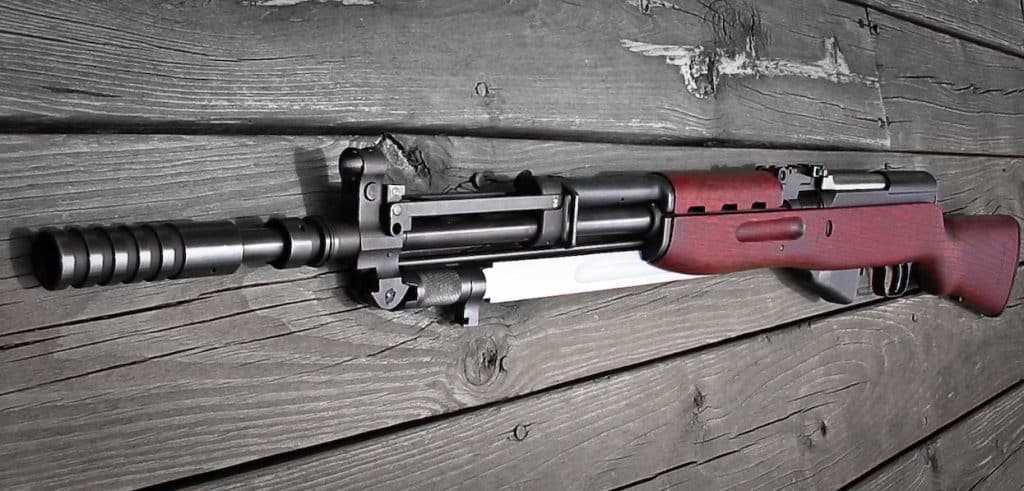Do you own a SKS and love the piece of history the semi-automatic carbine represents? Have you noticed that it’s not functioning as well as it used to? Have your shots been wildly off?
You may need to clean your gun. While no one disagrees that you need to clean firearms regularly, people do argue over how often you need to clean it. I recommend every two trips to the firing range or every 250 rounds (whichever comes first).
Cleaning the SKS can be tricky, and it was for me too. I did some research and practiced to figure it out. Read on to learn how to clean SKS.

WHAT YOU’LL NEED
SKS Cleaning Kit – A cleaning kit isn’t an absolute necessity, but for the low price, you may as well get one. This one comes with a rod handle, fitted bore brush, takedown tool, and a metal tube to store it in.
WD-40 – If you don’t have this in your workspace already, you need to get it as soon as possible. WD-40 is the king of all mechanical lubricants. I know that when I run out at home, it’s an instant trip to my local hardware store to get more.
Vise Block – While you don’t need this, it’s really helpful. Securing your carbine in a vise keeps it steady while you work on it and prevents scratches. The way this vise block works is by locking the block into the magazine well you can then put the block in a vise. Your gun is protected from the pressure of the vise, but it’s still held completely still.
Cleaning Rag – You can get away with any microfiber cloth or even a gentle rag. Or you can try these. You need something gentle on the gun to remove fingerprints and scrub off grime.
And that’s it! You’re ready for the next step which cleaning the SKS.
How To Clean SKS: Step By Step
In this part we take you step by step through the process of cleaning your SKS. Make sure to read each step carefully and also reference the video as needed. Cleaning the SKS isn’t that hard, but if you’re not careful you could find yourself with a disassembled firearm with little idea of how you got there.
1) GATHER YOUR MATERIALS AND SET UP YOUR WORKSPACE
You can get this done in under 15 minutes if you prepare your materials and space properly. Find a clear table and spread out some newspaper or cloth to put the dissembled parts on.
The grease can stain your work table if you’re not careful. Putting the paper or cloth down can protect the table and prevent scratches on the parts.
Keep your kit and materials nearby. This is a big time-saver.
Insert the vise block, and then put the gun into a vise. You may want to take the time to wipe down the outside of the SKS with some WD-40 and your cleaning cloth.
Don’t worry! WD-40 doesn’t affect the wood of the gun.
2) REMOVE THE RECEIVER
With your gun secure, go to the end of the receiver where you find the takedown lever. After checking that the bolt is closed, turn the lever counterclockwise.
The lever may be tight. Make sure you don’t hit any frozen parts to knock them loose. Tap it gently, use WD-40, or a takedown tool to work it free.
Pull out the receiver cover, spring, bolt carrier, and bolt. Take note of the exact position and orientation they came out in. Clean and brush them with WD-40.
Make sure the firing pin is free moving on the bolt. Also, get into the rails on the side of the bolt as well.
Pro-tip: As you put the parts down, try putting them down in the exact orientation they came out in. When I use paper, I draw arrows helping remind me where it came from.
3) CLEAN THE GAS SYSTEM
Use your takedown tool (or screwdriver) to pull up the selector lever where the bolt met the piston. Don’t pull it up too far or the spring may pop out.
The hand guard and gas cylinder pull out. It may be tough but just stick with it without hitting it.
When it does come out, remove the piston. Clean the inside of the gas cylinder and lubricate the piston. Your goal is to have the piston move freely in the tube.
Clean in the barrel where the cylinder meets the gas system. Use your brush and any other tools you need to wipe off grime and lubricate.
4) CLEAN THE BARREL
Use your brush and WD-40 to clean the inside of the barrel. Start from the receiver end of the barrel and run it through a few times. Don’t start from the muzzle end, you may damage the crown.
5) CLEAN THE TRIGGER GROUP
Using the brush, WD-40, and cloth clean the pins and screws off the trigger group. If your WD-40 comes with the straw that lets you spray into a tiny space, use that. If it doesn’t, you can always spray a Q-tip or spray the area and rub it with the Q-tip.
If you’d like to, you can also remove this part of the SKS by using the takedown tool to push the indentation behind the trigger guard into the free position. I don’t feel this is necessary if you regularly do light maintenance such as this.
6) REASSEMBLE THE SKS
Reverse the steps you just did to put the gun back together.
If you removed the trigger group, align the trigger before pushing it in. When you do put it back in, push it straight into the opening until you hear and feel it click into place.
Put the piston back into the gas cylinder but make sure it’s not flush on the breach end. Put the cylinder in muzzle end first and then press down the rest of the cylinder. Flip the lever back into place.
Insert the bolt. This is easier if the hammer is pulled back. Next, put the bolt carrier into the gun taking care to fit it into the grooves on the bolt and slide them both all the way forward.
Then, insert the recoil spring with the curved end first. Put the receiver cover onto the carrier and click the lever down to lock it in the place. Move the whole bolt back and forth to make sure everything is functioning correctly and smoothly.
There you go! You just cleaned your SKS.
COMMONLY ASKED QUESTIONS
Why do you need to clean your gun? – Every time you fire, there’s a bit of carbon that builds up. As the gun is carried from place to place, it is also exposed to moisture. The combination of buildup over time can damage the gun material and severely affect the bullet’s trajectory.
The damaged gun and wild trajectory can not only cause permanent problems for your gun and hunting but can also cause severe and sometimes deadly emergencies for those around you. Cleaning your gun isn’t just for your gun; it’s a safety issue.
What is a carbine? – A carbine is a rifle that forms the bridge between the long rifles and the early assault rifles such as the AK-47 which went on to replace the SKS for the Soviet Union’s front line service. The rifle is shorter and has the added semi-automatic gas system in place.
The shorter barrel make sit lighter and easier to carry. With a gas system, some energy (gas) expended when firing is redirected back into the firearm to automatically eject the empty cartridge and reload the next round. This allowed for faster firing and less recoil.
What is the effective range of the SKS? – When properly cleaned, the SKS has an effective range of 440 yards. This means that when the rifle is working properly you can expect to hit what you’re aiming at if the target is 440 yards or closer.
CONCLUSION
We hope you enjoyed learning how to clean SKS. This rifle is still considered to be one of the best carbine’s ever made, and it’s common to find it at the firing range or even while hunting. It has a light and easy carry weight coupled with an effective gas system.
Cleaning your gun is a serious responsibility. Going through these easy steps every 250 rounds or 1-2 times a year keeps your gun in good shape longer and keeps the people around you safer. So go clean your SKS now that you know how.
Take your time while you follow these steps, and always to make sure to follow basic gun safety. Most importantly, never point a gun towards a person and always act as if the gun is loaded. These two are key to safety.


